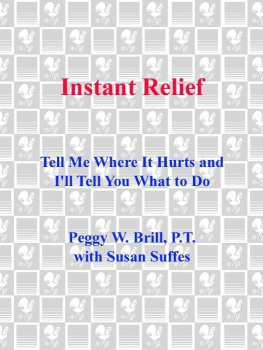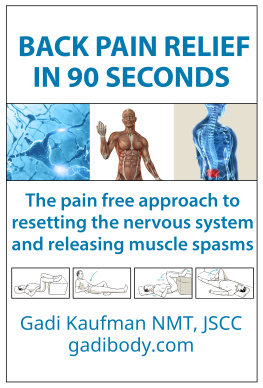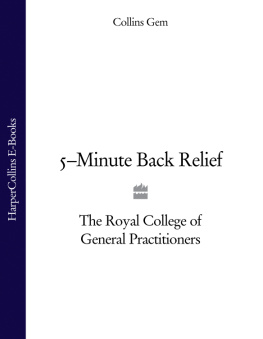"Nothing is more important to strength, health, and vitality than strong core muscles. I know this from both personal and professional experience. Peggy Brill's exercise program is effective for every woman, no matter what her current fitness level. And because it takes only 15 minutes per day, everyone can benefit."
---Christiane Northrup, M.D.,
author of Women's Bodies, Women's Wisdom
"I never thought I'd be free from back pain due to arthritis and hard living for my first forty years. Now forty-nine, I started the Core Program three and a half weeks ago and have just had four days in a row with absolutely NO PAIN! I'm ecstatic. I'm starting to believe my second forty years will be enjoyable after all!"
---Kathy Okay
"I am fifteen and in high school. I have gradually worked my way up to the Ultimate Core and have seen myself get more flexible and toned. I have recommended this program to my mom (age fifty), sister (age twelve), grandma (age eighty-one), and several of my friends and they have gotten excellent results too!"
---A reader from Glenview, Illinois, on Amazon
"I'm not very flexible and am constantly lifting my sixteen-month-old daughter. Needless to say, my back is continually aching. Even though I've only been doing this program for a week, already the soreness is diminished to the point where it is almost gone. I really thought I would have to deal with back pain for the rest of my life. What a relief, in more ways than one, to know I can do something about it. As an added bonus, my stomach is getting flatter---something that hasn't happened since before I was pregnant!"
---A reader from Pittsburgh, on Amazon
Also by Peggy W. Brill, P.T.
THE CORE PROGRAM
15 Minutes a Day
That Can Change Your Life
The exercises and suggestions in this book are guidelines
for the healthy individual. If you have specific medical
problems or are unsure whether you should perform
certain exercises, please consult your physician or
physical therapist.
INSTANT RELIEF
A Bantam Book / June 2003
Published by Bantam Dell
A Division of Random House, Inc.
New York, New York
All rights reserved
Copyright 2003 by Margaret Wachterhauser Brill
with Susan Suffes
Cover photograph 2003 by Sigrid Estrada
Illustrations by Meredith Hamilton
Book design by Amanda Kavanagh, ARK Design, NY
No part of this book may be reproduced or transmitted
in any form or by any means, electronic or mechanical,
including photocopying, recording, or by any
information storage and retrieval system, without the
written permission of the publisher, except where
permitted by law.
Bantam Books and the rooster colophon are
registered trademarks of Random House, Inc.
Library of Congress Cataloging-in-Publication Data
Brill, Peggy W.
Instant relief : tell me where it hurts, and I'll tell you what
to do / by Peggy W. Brill, with Susan Suffes.
p. cm.
eISBN: 978-0-307-41814-2
1. Stress management. 2. Stress (Physiology)---Exercise
therapy. 3. Stress (Psychology)---Exercise therapy.
I. Suffes, Susan. II. Title.
RA785 .B756 2003
155.9'042---dc21
2002038250
v3.1
For my greatest love and joy,
Madison and Maggie
Standing, Sitting, or Lying Down
Lying Down
Standing or Sitting
Lying Down
Standing or Sitting
Lying Down
Standing or Sitting
Standing or Sitting
Standing or Sitting
Lying Down
Standing
Sitting
Lying Down
Standing
Sitting
Lying Down
Standing
Sitting
Lying Down
Standing
Sitting
Lying Down
Standing
Sitting
Lying Down
E veryone knows that it is impossible to control all the stress that is an inevitable part of our daily lives. But stress-induced pain is another matter. The good news is that we can do something to control those sudden onsets of pain and discomfort, whenever and wherever they occur. You can get Instant Relief with the Brill exercises. A few simple movements---and relief is yours.
The fact that emotional stress can cause physical pain was never more evident to me than after the events of September 11, 2001. As a physical therapist practicing in Manhattan, I found that within forty-eight hours I was dealing with an epidemic of physical problems. Patients were phoning or just showing up with complaints about sudden unrelenting pain in all parts of their bodies. Necks were stiff. Backs were aching. Shoulders were tense. Knees and hips were sore. Over and over again I heard about pain that seemed to strike out of nowhere, almost all of it a manifestation of the emotional upheaval an entire nation was experiencing.

Pain occurs because part of the body's first-wave response to emotional stress is to tense the muscles. Certain muscles are particularly predisposed to this tightening, especially those in the upper neck, the shoulders, the jaw, and the muscles along the spine. In the lower back the connective tissue becomes tense and tight, too. When muscles and connective tissue tighten, nerves may become entrapped and blood flow becomes constricted, cutting off the oxygen and nutrients the muscles need. A neck ache or a backache is sure to follow.
The diaphragm, a key respiratory muscle located at the bottom of the rib cage, also responds to stress by tightening. Think about a time when you were under stress. How did you breathe? Unless you consciously made the decision to take the deep diaphragmatic breaths your body needed, you probably took rapid, shallow breaths, inhaling too little oxygen and exhaling incompletely so that your lungs did not make room for even the limited amount of oxygen you were inhaling. You may have noticed that your hands and feet were cold---a sure sign that not enough blood was circulating to your extremities. This is because shallow breathing constricts blood vessels, further contributing to the cutting off of the blood supply that is caused by the tightening of the other muscles in the body.
Headaches, backaches, neck pain, tingling and numbness in the hands---these are only some of the possible results of muscle tension and shallow breathing. Conversely, all of them can be relieved by proper breathing, and by balancing muscles through the stretching and strengthening exercises I'll be giving you in this book.
Stress is---and always has been---everywhere. It's in our offices, in our homes, in our relationships---and now more than ever, it's in the scary new world outside our front door. But stress is an inevitable part of the human condition, even in the best of times. So let's accept that fact, even as we focus on learning how to reject pain, its consequence. We









